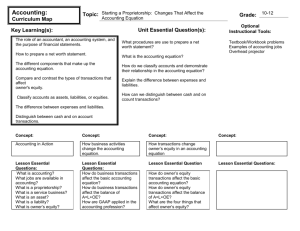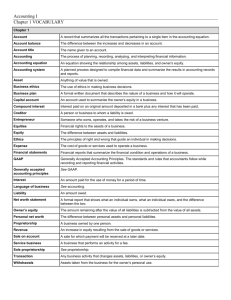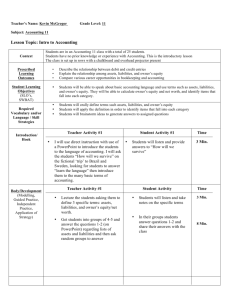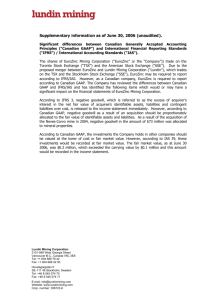Financial Statement Analysis
advertisement
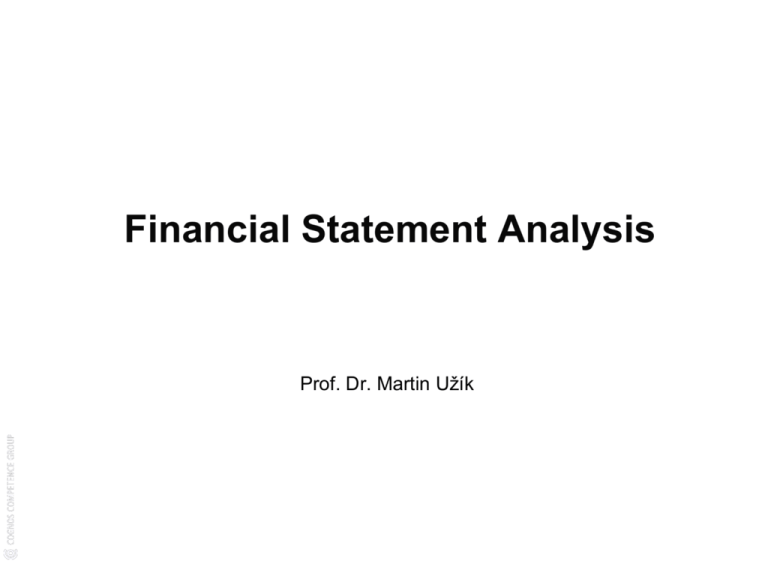
Financial Statement Analysis Prof. Dr. Martin Užík Source Aswath Damodaran Gregory Mostyn, CPA: Essentials of Financial Statement Analysis … Financial Statement Analysis - The balance sheet: summarizes what a firm owns and owes at a point in time. - The income statement: reports on how much a firm earned in the period of analysis - The statement of cash flows: reports on cash inflows and outflows to the firm during the period of analysis Financial Statement Analysis - A financial statement should reflect true and fair view of the business affairs of the organization. Liabilities Assets Fixed Assets Current Liabilities Current Assets Debt Financial Investments Other Liabilities Intangible Assets Equity The Financial Balance Sheet The Income Statement The Statement of Cash Flows Standards • IFRS (International Financial Reporting Standards) • principles-based standards, interpretations and the framework in 1989 adopted by the International Accounting Standards Board (IASB) • • • • • International Financial Reporting Standards (IFRS)—standards issued after 2001 International Accounting Standards (IAS)—standards issued before 2001 Standing Interpretations Committee (SIC)—issued before 2001 Conceptual Framework for the Preparation and Presentation of Financial Statements (2010) International Accounting Standards (IAS); IAS were issued between 1973 and 2001 by the Board of the International Accounting Standards Committee (IASC) Elements of financial statement (IAS 1 article 10) • Asset: An asset is a resource controlled by the enterprise as a result of past events from which future economic benefits are expected to flow to the enterprise. • Liability: A liability is a present obligation of the enterprise arising from the past events, the settlement of which is expected to result in an outflow from the enterprise' resources, i.e., assets. • Equity: Equity is the residual interest in the assets of the enterprise after deducting all the liabilities under the Historical Cost Accounting model. Equity is also known as owner's equity. Under the units of constant purchasing power model equity is the constant real value of shareholders´ equity. The financial performance of an enterprise is primarily provided in the Statement of Comprehensive Income (income statement or profit and loss account). Elements of income statement (IAS 1 article 10) • Revenues: increases in economic benefit during an accounting period in the form of inflows or enhancements of assets, or decrease of liabilities that result in increases in equity. However, it does not include the contributions made by the equity participants, i.e., proprietor, partners and shareholders. • Expenses: decreases in economic benefits during an accounting period in the form of outflows, or depletions of assets or incurrences of liabilities that result in decreases in equity. Standards • HGB (Handelsgesetzbuch) • the German code of commercial and company law Standards • US-GAAP (United States Generally Accepted Accounting Principles) • In the United States, GAAP is a set of rules and standards that guide accountants as to when and how to properly record transactions and how to prepare proper financial statements. GAAP is not like unchanging laws of physics. GAAP is designed to meet the needs of society. GAAP is always evolving as the economic environment changes. Also, GAAP only refers to rules of accounting in the United States. Financial Statement Analysis • Horizontal analysis - • is a comparison of financial statement information over a period of time. Both dollar amounts and percentage amounts are evaluated to identify changes and trends from the base year. Watching trends over an extended time period is an extremely valuable analytical procedure. Vertical analysis - A method of financial statement analysis in which the categories of accounts (assets, liabilities and equities) in a balance sheet is represented as a proportion of the total account. The main advantages of vertical analysis is that the balance sheets of businesses of all sizes can easily be compared. It also makes it easy to see relative annual changes within one business.


